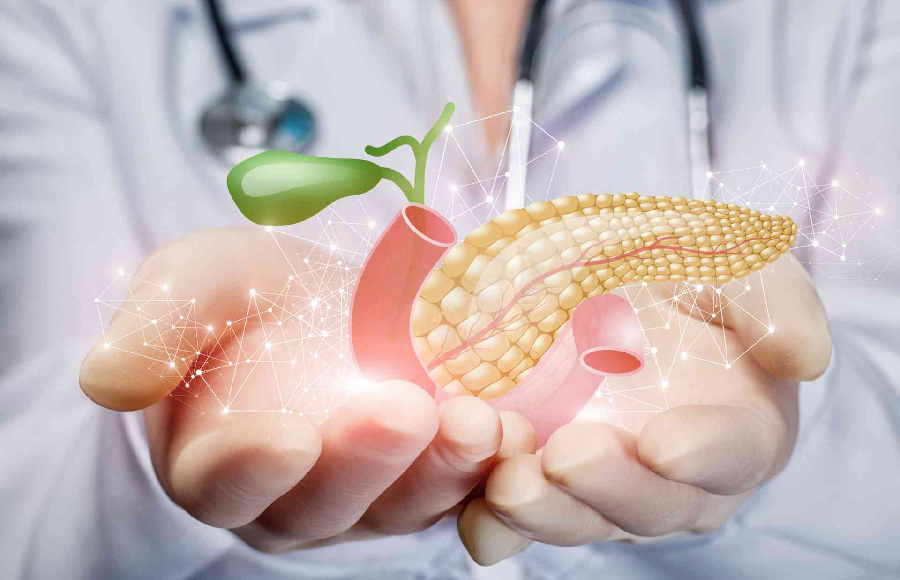How does dysphagia cause swallowing problems?
What is swallowing?
Swallowing is a very complex process in which the food we eat moves from the mouth to the stomach. In it, different muscular structures are synchronised with the participation of the nervous system.
It is divided into three phases:
- Oral or buccal: a voluntary phase that begins with chewing food that, mixed with saliva, forms the food bolus. Later, this is propelled by the tongue into the pharynx.
- Pharyngeal is an involuntary phase that activates the bolus as it goes. It consists of highly complex and coordinated mechanisms that propel food along the pharynx into the oesophagus while preventing the bolus from entering the airway through the larynx.
- Esophageal: this is also an involuntary phase, which begins when the food bolus reaches the oesophagus. Through a mechanism of rhythmic and automatic contraction (called peristaltic contraction) of the oesophagal muscle and the coordinated relaxation of the sphincter that separates the oesophagus from the stomach, the bolus passes into the latter, where the process ends.
What is dysphagia?
Dysphagia is the difficulty swallowing food – in general, both solid and liquid, in such a way that there is an alteration in the movement of the food bolus from the mouth to the stomach in any of the previously explained phases. This alteration may be due to both organic and functional causes.
People who suffer from it often describe the feeling that food does not go down well or that it gets stuck or stuck.
Although quite unknown and, in many cases, undiagnosed, it is crucial to detect dysphagia early because, otherwise, the quality of life can deteriorate greatly and become fatal. Fortunately, it is treatable and, in some cases, can even be cured.
Who is affected?
In general, the incidence of this disease is higher as people age. However, although age leads to swallowing changes, these alone do not have to cause dysphagia. Therefore, even in elderly people, underlying diseases must be ruled out whenever dysphagia appears, such as neurological or neurodegenerative, otorhinolaryngological, oesophagal or others that we will see later.
The World Gastroenterology Organization speaks of a prevalence rate of this disease of 11% in the general population.
According to the Gastroenterology Research Foundation (Furega), the incidence of this disorder is growing and affects 25% of the population over 70 years of age and between 30 and 40 million Europeans.
What types of dysphagia are there?
Depending on the phase of swallowing that is affected, there are two possible types of dysphagia:
- Oropharyngeal: Swallowing suffers alterations in the oral and/or pharyngeal phase. This is the one that predominates in the elderly population, associated with neurological disorders, such as stroke, Parkinson’s disease and Alzheimer’s, among others.
- Esophageal: the affected phase is oesophagal. The diseases that cause it can affect the mobility of the oesophagus or cause some obstruction that prevents or hinders the passage of the food bolus from the oesophagus to the stomach. The diseases that cause it are more varied and may have a more specific treatment.
What are the causes of dysphagia?
The Spanish Digestive System Foundation (FEAD) divides them, in general, into:
- Diseases that affect the mucosa: decrease the passage space of the food bolus. For example, intraesophageal tumours or infections such as oesophagal candidiasis.
- Diseases that affect the muscle involved in each phase include the upper oesophagal sphincter or the oesophagal musculature.
- Diseases of the central or peripheral nervous system prevent the generation of the appropriate nervous stimulus or do so uncoordinatedly. Consequently, the muscles of the different areas do not contract properly.
- Diseases that affect structures adjacent to the swallowing system: such as the larynx or the thyroid, which come to compress or invade it.
In addition, depending on the types of dysphagia that we have explained before, we can detail, in general terms, the following causes:
Causes of oropharyngeal dysphagia:
Neuromuscular causes: Cerebrovascular accident, Parkinson’s disease, Myasthenia Gravis, dementia, Multiple Sclerosis, Amyotrophic Lateral Sclerosis (ALS), peripheral nerve diseases (peripheral neuropathies) or muscle diseases (myopathies).
Obstructive lesions:
-
- Goitre
- Malignant tumours in that area
- Masses in the anterior mediastinum (a space located in the centre of the chest, behind the sternum)
Causes of oesophagal dysphagia:
- Neuromuscular: achalasia (a disorder of the oesophagus), Diffuse Esophageal Spasm, hypertension of the lower oesophagal sphincter, connective tissue diseases (Scleroderma, Lupus, Rheumatoid Arthritis),…
- Lesions that cause obstruction: either intrinsically (for example, tumours, oesophagal membranes or rings, foreign bodies in the oesophagus, oesophagal narrowing due to chemicals, radiotherapy, infections.) or extrinsically (mediastinal masses, vascular alterations, which compress the structure oesophagus).
What are your first symptoms?
Dysphagia can range from mild to severe. In any case, it is a serious symptom that requires immediate evaluation. Often, people who suffer from it are not aware of its symptoms, which can be:
- Difficulty initiating swallowing or the need to swallow several times.
- The sensation of stopping or obstruction of food in any section from the throat to the stomach entrance.
- Cough when ingesting solids or liquids.
- Fall of food from the mouth or drooling when eating.
- The sensation of residue in the mouth or pharynx and having to swallow several times.
- Pain.
- Nausea, vomiting or regurgitation (the return of food to the mouth).
- Voice alterations: nasal voice.
What other consequences and complications can cause dysphagia?
Difficulty swallowing can lead to the following complications:
- Malnutrition, malnutrition or weight loss for no apparent reason may be the only visible symptom.
- dehydration
- Respiratory tract infections – such as recurrent acute pneumonia or chronic lung diseases. They result from the affected person inhaling secretions or part of the food he eats or drinks. They can be very serious, even fatal.
- If food passes into the respiratory tract, choking can also occur.
- In general, a deterioration in the quality of life can occur since many patients cannot eat normally and change their dietary habits. Hospital admissions may be necessary, resulting in greater dependency, social isolation, a greater burden of care and institutionalisation of these people.
- Occasionally, dysphagia can lead to aphagia, the complete inability to swallow. In this case, assisted feeding through tubes must be used.
How is dysphagia treated?
As we have mentioned, it is crucial to make an early diagnosis of the disease, whose treatment can greatly improve the patient’s quality of life. However, specific treatment depends on the degree of severity and the cause of this disease.
Dysphagia can sometimes be completely or partially cured without resorting to invasive methods. In others, a specific treatment depending on the cause can be considered, if possible. Therefore, in all cases, it is important to maintain oral feeding for as long as possible.
In general terms, the following lines can be followed to guarantee the efficiency (which allows adequate nutrition and hydration) and the safety (that the food does not “sneak” through the respiratory tract) of swallowing:
- Changes in diet and/or in the way of eating: its objective is to reduce the risk of aspiration. It can consist of grinding foods or adding thickeners to modify their consistency, as well as learning new ways of eating and chewing (they consist of learning some postural techniques and compensatory manoeuvres).
- Swallowing rehabilitation: since it has been shown to reduce malnutrition and the incidence of aspiration pneumonia. It is based on strengthening the muscles involved in expiration and swallowing.
- Other more specific treatments that will depend on the cause of the dysphagia: include dilatations of the oesophagus, drugs or various types of surgery.
- The insertion of feeding tubes: may be necessary when the previous measures fail to guarantee the efficiency and safety of swallowing.
10 Tips to facilitate swallowing in dysphagia
Following guidelines when preparing and consuming food can greatly facilitate the swallowing process for those suffering from this disease. However, in any case, you should always follow the recommendations of your doctor and rehabilitation team according to your specific case:
- Crush solid foods before eating them.
Pass them through the food mill until you obtain a homogeneous texture without lumps, thorns or filaments. It is better not to add more liquid than necessary, so the food does not lose nutrients. So yes, milk or sauces can be added to make the texture smoother.
- deliciously prepare the dishes.
This way, you will feel like eating more.
Also, make sure you serve them at the right temperature. Another key to stimulating appetite is to vary foods and avoid monotony.
- Avoid dishes that mix different consistencies and textures.
Above all, solids and liquids, such as noodle soup, milk with cereals, or chunky yoghurts, can disperse in the mouth and cause choking. Foods that give off the water when bitten, such as watermelon or orange, or those that can go from solid to liquid in the mouth, such as ice cream, are also not suitable.
- Avoid fruits and vegetables with seeds or skin.
For example, grapes, peas, tangerines, kiwis or strawberries have seeds or skin that cannot be separated. Foods that crumble in the mouth, such as biscuits or muffins, greasy foods that spread (rice, pasta, whole vegetables) or crunchy and dry foods such as cookies and bagged potatoes, are also not suitable. Similarly, discard fibrous foods (pineapple, asparagus) and those that may contain bones, tendons or thorns.
- Substitute water for thickened drinks or jellies.
To do this, you can use the thickeners sold in pharmacies or gelatins in food stores. Follow the instructions on the package to obtain a smooth and uniform dough with a unique texture and without lumps. Also, avoid liquids with pulp, such as unstrained orange juice.
- Take food in small quantities.
To achieve this, it is recommended that you use dessert spoons to eat and drink and take only what fits in each spoonful at a time. You better not use straws or feeding syringes.
- Eat slowly and avoid talking while you are eating.
Also, make sure to leave enough time between spoonfuls, ensuring that there is no food in the mouth before the next spoonful.
- Be careful with candies, pills and gum.
They stimulate the production of saliva, which can pass into the respiratory tract.
- Take care of your posture during and after meals.
Either sitting or raised on the bed, try to be comfortable. For example, choose a chair on which you can rest your arms, get a footrest, or use a pillow to keep you in the right position.
- Do not lie down right after eating.
In general, avoid meals half an hour before going to sleep and, when you do, raise the head of the bed.





